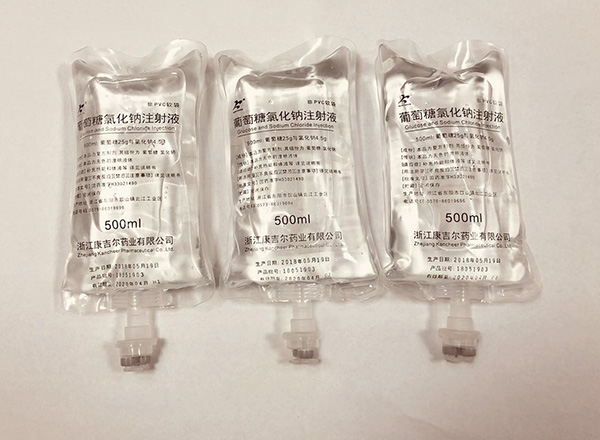Product & Service

【Drug Name】
Common Name: Glucose and Sodium Chloride Injection
Product name:Glucose and Sodium Chloride Injection
?
【Ingredients】
This product is a compound preparation, the main components of which are glucose and sodium chloride.
【Properties】
This product is a colorless clear liquid.
【Indications】
Supplements heat and body fluids.?Used for a variety of reasons for eating insufficient or a large amount of body fluid loss.
【Specification】
(1) 50 ml; (2) 100 ml; (3) 250 ml; (4) 500 ml.
【Adverse reactions】
(1) too much infusion, too fast, can cause sodium retention, causing edema, elevated blood pressure, increased heart rate, chest tightness, difficulty breathing, and even acute left heart failure.
(2) inappropriately administered hypertonic sodium chloride can cause hypernatremia.
(3) too much, too fast to give hypotonic sodium chloride can cause hemolysis, brain edema and so on.
(4) Phlebitis: occurs during the infiltration of hypertonic Glucose Injection.?Switching to large intravenous drip, the incidence of phlebitis decreased.
(5) If the high concentration solution is injected, it may cause local swelling and pain.
(6) Reactive hypoglycemia: a combination of excessive insulin use, the original tendency of hypoglycemia and the sudden stop of total intravenous nutrition therapy are prone to occur.
(7) hyperglycemia non-ketotic coma: more common in diabetes, stress, the use of high-dose glucocorticoids, uremia peritoneal dialysis patients with intraperitoneal administration of hypertonic glucose solution and total intravenous nutrition therapy.
(8) Electrolyte disorder: low potassium, low sodium and hypophosphatemia are prone to occur when glucose is directly supplied for a long time.
【taboo】
(1) brain, kidney, heart dysfunction; (2) low plasma protein; (3) uncontrolled patients with diabetes and ketoacidosis; (4) patients with hyperosmolar dehydration; (5) hyperglycemia non-ketone Hyperosmolar state.
【Precautions】
(1) The following conditions should be used with caution: 1 edema disease, such as nephrotic syndrome, cirrhosis, ascites, congestive heart failure, acute left heart failure,
Cerebral edema and idiopathic edema; 2 acute renal failure oliguria, chronic renal failure decreased urine output and poor response to diuretics; 3 hypertension; 4 hypokalemia; 5 elderly and children rehydration volume and Speed ??should be strictly controlled.
(2) follow-up examination: 1 serum sodium, potassium, chlorine concentration; 2 blood acid-base balance indicators; 3 renal function; 4 blood pressure and cardiopulmonary function.
(3) Injecting too much glucose during childbirth can stimulate fetal insulin secretion, and the baby will have hypoglycemia after birth.
(4) The following conditions should be used with caution: 1 periodic paralysis, hypokalemia patients; 2 stress state or application of glucocorticoids can easily induce hyperglycemia; 3 edema and severe heart, renal insufficiency, cirrhosis, ascites are easy to cause Water retention should control the amount of fluid infusion; especially those with cardiac dysfunction should control the rate of drip.
【Pregnant women and lactating women】 is not clear.
【Children's medication】 The amount and speed of rehydration should be strictly controlled.
【Geriatric Use】 The amount and speed of rehydration should be strictly controlled.
【Drug Interactions】 This experiment was not performed and there is no reliable reference.
【Drug overdose】 can cause hypernatremia and hypokalemia, and can cause loss of bicarbonate.
【Pharmacology and Toxicology】
Glucose is one of the main sources of heat in the body.?Sodium and chlorine are important electrolytes in the body, mainly in the extracellular fluid, which plays an important role in maintaining the normal blood and extracellular fluid volume and osmotic pressure.
【Pharmacokinetics】 After glucose enters the human body, the normal human body utilizes 6 mg/kg per minute.
【Storage】 sealed and stored.
【Package】 non-PVC soft bag [pull ring, easy to fold (double valve)]: 50ml / bag × 80 bags; 100ml / bag × 80 bags; 250ml / bag × 40 bags; 500ml / bag × 20 bags.
【Validity period】 24 months.
【Executive Standards】 The second edition of the 2015 edition of the Chinese Pharmacopoeia.
【Approval Number】
50 ml: 2.5 g of glucose and 0.45 g of sodium chloride |
National medicine standard word H20113016 |
100ml: glucose 5g and sodium chloride 0.9g |
National medicine standard word H33022594 |
250ml: glucose 12.5g and sodium chloride 2.25g |
National Medicine Zhunzi H20045168 |
500ml: 25g of glucose and 4.5g of sodium chloride |
National medicine standard word H33021490 |
【Manufacturer】
Company Name: Zhejiang Kancheer Pharmaceutical Co., Ltd.
Production address: Beijiang Industrial Zone, Geshan Town, Dongyang City, Zhejiang Province, China
Website: tianshicheng.cn
Zip code: 322105
Tel: (0579) 86019696 86019610
Fax number: (0579) 86019611
